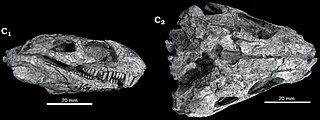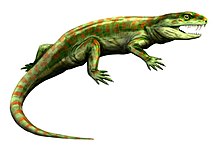
Synapsids are a group of animals that includes mammals and every animal more closely related to mammals than to the other members of the amniote clade, such as reptiles and birds. Unlike other amniotes, they have a temporal fenestra, an opening low in the skull roof behind each eye, leaving a bony arch beneath each; this accounts for their name. Primitive synapsids are usually called pelycosaurs or pelycosaur-grade synapsids. This informal term consists of all synapsids that are not therapsids, a monophyletic, more advanced, mammal-like group. The non-mammalian synapsids were described as mammal-like reptiles in classical systematics, but this misleading terminology is no longer in use as synapsids as a whole are no longer considered reptiles. They are now more correctly referred to as stem mammals or proto-mammals.

Dimetrodon is an extinct genus of non-mammalian synapsid that lived during the Cisuralian, around 295–272 million years ago (Mya). It is a member of the family Sphenacodontidae. The most prominent feature of Dimetrodon is the large neural spine sail on its back formed by elongated spines extending from the vertebrae. It walked on four legs and had a tall, curved skull with large teeth of different sizes set along the jaws. Most fossils have been found in the Southwestern United States, the majority coming from a geological deposit called the Red Beds of Texas and Oklahoma. More recently, fossils have been found in Germany. Over a dozen species have been named since the genus was first erected in 1878.

The pelycosaurs were previously considered an order, but are now only an informal grouping composed of basal or primitive Late Paleozoic synapsids, formerly called mammal-like reptiles. They consist of all synapsids excluding the therapsids and their descendants.

Edaphosaurus is a genus of extinct edaphosaurid synapsids that lived in what is now North America and Europe around 303.4 to 272.5 million years ago, during the late Carboniferous to early Permian periods. American paleontologist Edward Drinker Cope first described Edaphosaurus in 1882, naming it for the "dental pavement" on both the upper and lower jaws, from the Greek edaphos έδαφος and σαῦρος ("lizard").

Sphenacodontidae is an extinct family of small to large, advanced, carnivorous, Late Pennsylvanian to middle Permian pelycosaurs. Primitive forms were generally small, but during the later part of the early Permian these animals grew progressively larger, to become the top predators of their environments. Sphenacodontid fossils are so far known only from North America and Europe.

Eupelycosauria is a large clade of animals characterized by the unique shape of their skull, encompassing all mammals and their closest extinct relatives. They first appeared 308 million years ago during the Early Pennsylvanian epoch, with the fossils Archaeothyris and perhaps an even earlier genus, Protoclepsydrops, representing just one of the many stages in the evolution of mammals, in contrast to their earlier amniote ancestors.

Caseasauria is one of the two main clades of early synapsids, the other being the Eupelycosauria. Caseasaurs are currently known only from the Late Carboniferous and the Permian, and include two superficially different families, the small insectivorous or carnivorous Eothyrididae, and the large, herbivorous Caseidae. These two groups share a number of specialised features associated with the morphology of the snout and external naris.

Caseidae is an extinct family of synapsids from the Carboniferous and Permian period. It was a widespread group of very primitive herbivorous, possibly aquatic synapsids, which appeared during the late Carboniferous and persisted over 30 million years until the late middle Permian. Estemmenosuchids replaced the caseids as the dominant megaherbivores of the Wordian age.

Tetraceratops insignis is an extinct synapsid from the Early Permian that may be the first known representative of Therapsida, a group that includes mammals and their close extinct relatives. It is known from a single 90-millimetre-long (3.5 in) skull, discovered in Texas in 1908. According to a 2020 study, it should be classified as a primitive non-therapsid sphenacodont rather than a genuine basal therapsid.

Ophiacodon is an extinct genus of synapsids belonging to the family Ophiacodontidae that lived from the Late Carboniferous to the Early Permian in North America and Europe. The genus was named along with its type species O. mirus by paleontologist Othniel Charles Marsh in 1878 and currently includes five other species. As an ophiacodontid, Ophiacodon is one of the most basal synapsids and is close to the evolutionary line leading to mammals.

Secodontosaurus is an extinct genus of "pelycosaur" synapsids that lived from between about 285 to 272 million years ago during the Early Permian. Like the well known Dimetrodon, Secodontosaurus is a carnivorous member of the Eupelycosauria family Sphenacodontidae and has a similar tall dorsal sail. However, its skull is long, low, and narrow, with slender jaws that have teeth that are very similar in size and shape—unlike the shorter, deep skull of Dimetrodon, which has large, prominent canine-like teeth in front and smaller slicing teeth further back in its jaws. Its unusual long, narrow jaws suggest that Secodontosaurus may have been specialized for catching fish or for hunting prey that lived or hid in burrows or crevices. Although no complete skeletons are currently known, Secodontosaurus likely ranged from about 2 to 2.7 metres (7–9 ft) in length, weighing up to 110 kilograms (250 lb).
Casea is an extinct genus of medium to large-bodied, herbivorous, pelycosaur synapsids from the late Carboniferous until the middle Permian. The name Casea references its appearance from the Caseasauria which developed new morphology of their external naris and snout. Casea were known to be about 1.2 meters long. It weighed between 150 kg to 200 kg. It was slightly smaller than the otherwise very similar Caseoides. Casea was one of the first amniote herbivores, sharing its world with animals such as Dimetrodon and Eryops. It was possibly also aquatic.

Eothyris is a genus of extinct synapsid in the family Eothyrididae from the early Permian. It was a carnivorous insectivorous animal, closely related to Oedaleops. Only the skull of Eothyris, first described in 1937, is known. It had a 6-centimetre-long (2.4-inch) skull, and its total estimated length is 30 centimetres. Eothyris is one of the most primitive synapsids known and is probably very similar to the common ancestor of all synapsids in many respects. The only known specimen of Eothyris was collected from the Artinskian-lower.

Oedaleops is an extinct genus of caseasaur synapsids from the Early Permian of the southwestern United States. Fossils have been found in the Cutler Formation in New Mexico, which dates back to the Wolfcampian stage of the Early Permian. All remains belong to the single known species Oedaleops campi. Oedaleops was closely related to Eothyris, and both are part of the family Eothyrididae. Like Eothyris, it was probably an insectivore.

Aerosaurus is an extinct genus within Varanopidae, a family of non-mammalian synapsids. It lived between 252-299 million years ago during the Early Permian in North America. The name comes from Latin aes (aeris) “copper” and Greek sauros “lizard,” for El Cobre Canyon in northern New Mexico, where the type fossil was found and the site of former copper mines. Aerosaurus was a small to medium-bodied carnivorous synapsid characterized by its recurved teeth, triangular lateral temporal fenestra, and extended teeth row. Two species are recognized: A. greenleeorum (1937) and A. wellesi (1981).
Baldwinonus is an extinct genus of basal synapsids from the Early Permian. The type species is Baldwinonus trux, named in 1940 from the Cutler Formation of New Mexico. A second species, Baldwinonus dunkardensis, was named in 1952 from Ohio. Baldwinonus was first classified in the family Eothyrididae, but the group has since been recognized as a wastebasket taxon for many early synapsids. More recently, Baldwinonus has been placed in the family Ophiacodontidae. Its phylogenetic relationship to other early synapsids remains poorly understood because it is only known from a few fragments of bone.

Ianthodon is an extinct genus of basal sphenacodont synapsids from the Late Carboniferous about 304 million years ago. The taxon was discovered and named by Kissel & Reisz in 2004. The only species in the taxon, Ianthodon schultzei, was found by separating it from a block that also contained the remains of Petrolacosaurus and Haptodus. The evolutionary significance of the taxon wasn't realized until a publication in 2015. The fossil of this organism was discovered in Garnett, Kansas.

Heleosarus scholtzi is an extinct species of basal synapsids, known as pelycosaurs, in the family of Varanopidae during the middle Permian. At first H. scholtzi was mistakenly classified as a diapsid. Members of this family were carnivorous and had dermal armor, and somewhat resembled monitor lizards. This family was the most geologically long lived, widespread, and diverse group of early amniotes. To date only two fossils have been found in the rocks of South Africa. One of these fossils is an aggregation of five individuals.

Euromycter is an extinct genus of medium-sized caseid synapsids from Early (Artinskian-Kungurian) or Middle (Roadian-Wordian) Permian deposits of Southern France. The holotype and only known specimen of Euromycter (MNHN.F.MCL-2) includes the complete skull with lower jaws and hyoid apparatus, six cervical vertebrae with proatlas, anterior part of interclavicle, partial right clavicle, right posterior coracoid, distal head of right humerus, left and right radius, left and right ulna, and complete left manus. It was collected by D. Sigogneau-Russell and D. Russell in 1970 at the top of the M1 Member, Grès Rouge Group, near the village of Valady, Rodez Basin. It was first assigned to the species "Casea" rutena by Sigogneau-Russell and Russell in 1974. More recently, it was reassigned to its own genus, Euromycter, by Robert R. Reisz, Hillary C. Maddin, Jörg Fröbisch and Jocelyn Falconnet in 2011. The preserved part of the skeleton suggests a size between 1,70 m (5,5 ft) and 1,80 m (5,9 ft) in length for this individual.



















